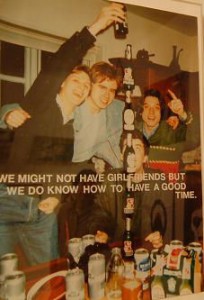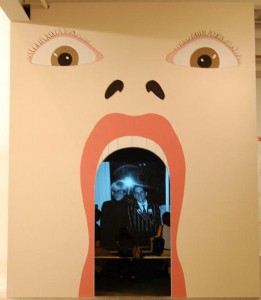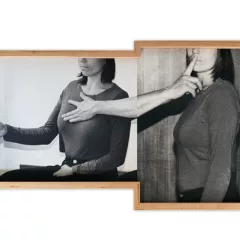Jeremy Deller’s Joy in People, an interactive exhibition including film, music, photography, installation, and lots and lots of banners, is a fantastic example of self-contained environment as art experience. Mounted by the Institute of Contemporary Art, this show could easily and enjoyably occupy several hours with the wide range of material presented. In the largest room, there’s a recreation of a Manchester tea shop giving away free cups of tea, with museum staff serving patrons, while telling them that this tea shop was actually a float in a Manchester parade Deller organized. Elsewhere, a reading table sits with vintage copies of NME containing articles focused on the troubled early 90s period of Manchester band The Happy Mondays.

Deller has said that he doesn’t like to make things, but prefers to do things to or with people. In terms of discernible genre, he’s an agitator who gets people to make works that he envisions.
Included in Joy in People is a recreation of “Open Bedroom” (1993), when the artist opened up his bedroom at his parents’ house while they were away on vacation.

Posters and pictures in the room demarcate the cultural signposts that shaped Deller’s identity growing up in Manchester. This exhibitionistic impulse, combined with the artist’s intense interest in provoking reactions in his audience, is consistent throughout his work.

The strands of English cultural history over the past three decades resonate with Americans’ experiences of the Rust Belt and the decline of blue-collar manufacturing jobs altering the social fabric — but some of the details are a little different. A 1984-5 miners’ strike in Manchester, where Deller grew up, was a crucial formative event. He eventually got former miners and actors to reenact a violent clash between police and miners, filmed by Mike Figgis as “The Battle of Orgreave (An Injury to One is an Injury to All)” (2004). An entire room at Joy in People is dedicated to historical documentation of the Manchester miners’ plight.

The plight of England’s miners is referenced in multiple pieces, even “Brass House,” a musical project by Manchester’s William Fairey Brass Band, whom Deller persuaded to cover acid house music. Seemingly completely random at first, Deller actually makes a convincing case for the connections between the two genres, and the final product is a sublime combination that turns seeming opposites into something truly unique.
“What Time is Love,” originally by KLF, is an acid house song covered by the William Fairey Brass band for their “Acid Brass” album, which was conceived of by Deller.
Joy in People was apparently a bit stronger in its London presentation at the Hayward Gallery. Live performers read texts to make viewers feel melancholy in one area. More notably for American audiences is the absence of “It Is What It Is,” 2009, the remains of a car that was detonated in Baghdad during the Iraq war. (Deller previously visited Philadelphia with the piece in 2009 ). But generally speaking, it’s a badge of pride for Philly that this Turner Prize-winning artist’s first mid-career retrospective landed here at the ICA.

Deller’s passionate for English music and his native Manchester. One documentary at the show is about The Happy Mondays’ eccentric dancer/maracas player Mark “Bez” Berry. Deller also made a documentary about fans of the band Depeche Mode. A documentary about Deller is also on view.

The entire show extends the domestic feeling of “Open Bedroom,” perhaps to encourage long visits. I allotted less than an hour to see the show and hope to go back soon. There’s hours of film to watch, and more material than this review can encompass. If at first glance the subjects don’t seem interesting, the longer you subject yourself to Deller’s uniquely penetrating gaze at social and cultural phenomena, the more interested you will be.

One corner of the show is labeled “My Failures” and includes designs for abandoned works or rejected proposals, including Deller’s design for a Stonehenge triptych as the main entrance to the Olympics in London. The idea didn’t die, instead transforming into Deller’s latest work, “Sacrilege,” a recreation of the entire Stonehenge circle as a bouncy castle for people to play on. It toured England over the summer.
Jeremy Deller: Joy in People will be on display at the Penn ICA through December 30.









